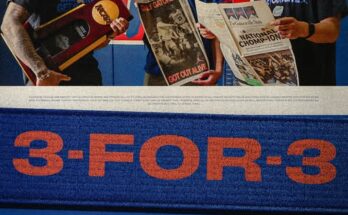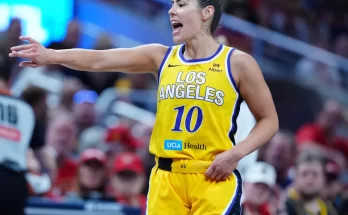The Golden State Warriors have recently announced a strategic move aimed at reinforcing their draft assets and future potential by acquiring the draft rights to Will Richard, the promising athlete selected at No. 56 overall in the NBA Draft by the Memphis Grizzlies. The trade, details of which remain under negotiation, was confirmed by both franchises and has been described as nearing completion, with only the finalization of contractual and procedural details pending. This transaction is significant for both teams involved, shaping their respective strategic plans and impacting the broader dynamics of talent acquisition and roster construction in the league.
In today’s landscape of professional basketball, draft rights are a critical commodity, offering teams the flexibility to enhance their roster without immediately expending salary cap or luxury tax space. The Warriors’ acquisition of Richard’s draft rights illustrates a calculated approach to investing in high-upside talent, someone who might not have been considered a high lottery pick but whose potential has captured the interest of scouts and decision-makers. At No. 56, many players are viewed as long shots, yet the right combination of athleticism, skill, and development trajectory can translate into meaningful contributions at the NBA level. In this case, Will Richard is seen as one of those names—an intriguing blend of strengths and traits that align with Golden State’s preference for versatile wing players who can stretch the floor, defend multiple positions, and exhibit the high basketball IQ required to thrive in coach Steve Kerr’s system.
The process that led to this acquisition began months prior, with the Warriors’ front office diligently scouting late first-round and early second-round prospects. While marquee names understandably garner more media attention and fanfare, astute franchises know where value can be found deeper in the draft. Golden State applied this wisdom in targeting Richard, a prospect whose college performance demonstrated his ability to stretch the floor from beyond the arc, defend aggressively, and absorb the complexities of high-level offensive sets. Though he didn’t headline draft discussions, his combination of three-point shooting, defensive willingness, and size made him an attractive low-risk, high-reward talent.
On the other side, the Grizzlies’ decision to trade away the rights to Richard speaks to a broader strategic maneuver. Memphis has consistently sought to build around their core of young, athletic players and to utilize future assets as leverage in trades that maintain competitive momentum while ensuring financial flexibility. By parting with Richard’s rights, the Grizzlies free up future draft considerations and possibly clear space for other moves. Their decision suggests that while they respect Richard’s potential, Memphis ultimately prioritized other assets and strategies in constructing their roster pipeline.
With the trade announcement, the finishing steps involve the usual administrative procedures—the preparation of the trade documentation, review by the NBA’s front office, and compliance checks related to roster and salary structures. As is common with transactions involving draft rights, the practical implications won’t take effect until the next official league date when trade agreements must be submitted and processed. Anticipated to be finalized before training camp or summer league, this timeline allows Golden State to integrate Richard into their development plans without any delay.
From a basketball perspective, Richard brings several intriguing qualities. League scouts have underscored his shooting accuracy, noting that he possesses a quick release and respectable range, giving him the capacity to space the floor and serve as a secondary or tertiary offensive threat. His three-and-D potential appeals to a team culture that places a premium on players who can make an immediate impact on both ends. Given Golden State’s recent seasons—featuring a rotation heavy on multipositional players like Klay Thompson, Andrew Wiggins, and others—Richard appears to fit the mold of a wing who can guard effectively, shoot efficiently, and adapt to the team’s rhythm.
Moreover, the Warriors are renowned for their player development capabilities. With access to elite coaching, analytics, sports science, and a genotype of winning culture, Golden State has repeatedly turned late-round selections into impactful rotation pieces. While not every player succeeds, Golden State’s track record—evident in the emergence of role players from seemingly modest draft positions—is a leading reason why Richard was an attractive asset. Within their system, his shooting mechanics, defensive instincts, and basketball intelligence could all be refined and accentuated, raising the ceiling of what he may become at the NBA level.
The acquisition aligns with Golden State’s recent philosophy on roster construction. While the franchise has prioritized retaining veteran leadership, overall fit, and two-way play, they’ve also remained conscience of the salary cap and the necessity to inject youth and cost-effective talent. Richard’s rights now occupy a spot that allows flexibility—whether the team ultimately signs him straight away, applies a “draft-and-stash” approach, or keeps him within the G League system to monitor his progression. The RightstoChoose model is particularly helpful in these situations, allowing the front office to evaluate performance during summer league, offseason workouts, and preseason while retaining negotiating advantage.
For Will Richard, this development shapes his professional trajectory in a positive way. Having heard his name called by the Grizzlies, he now finds himself in a Warriors organization with championship pedigree and a reputation for drawing out his players’ best games. His professional debut at summer league will be highly anticipated—not only by watchers interested in his individual outcome but also by observers charting how Golden State integrates new talent into their system. Over the offseason, Richard’s performance during workouts, rapport with coaching staff, and adaptability to playbook drills will dictate how soon he might join the main roster or carve out dedicated developmental time.
This trade also invites reflection on a broader theme in the NBA: the value of late-round draft assets. In an ecosystem where first-round picks are the lion’s share of attention and trade capital, players selected late are still pivotal pieces—especially for teams prioritizing efficient talent acquisition. True, they are rarely transformational faces, but when nurtured effectively, they can flourish into reliable components within a balanced roster. Golden State’s choice to invest in Richard at No. 56 underscores that philosophy—especially amid increasing usage of analytics, shooting trends, and efficient schemes.
Closer to a new season, fans and analysts will watch to see whether Golden State invites Richard to training camp with a guaranteed roster spot, gives him a two-way contract, or transitions him into a G League affiliate to refine his game. Whichever path is chosen, it’s clear the organization envisions genuine upside and has confidence in their capacity to optimize his skills. The Warriors have historically elevated late-round possessions into longer-term value—evident in players who arrived on modest contracts yet earned themselves rotation consideration through positional versatility and cerebral play.
That said, the journey from draft rights acquisition to regular rotation performer is nonlinear and subject to myriad variables: injuries, competition for roster space, in-season development, and serendipity. Richard joins a wing group stacked with veterans, upcoming free agents, and fellow draft picks; opportunities will emerge but must be earned. As with any developmental prospect, patience and resilience will be crucial, both for him personally and for the front office in charting a steady developmental path. While the first steps involve summer league showings and small-group workouts, the ultimate test will occur when real game minutes are on the line. Whether in G League scrimmages or garbage-time in NBA contests, how Richard responds—both instinctively and under direction—will determine his upward trajectory.
Weighing the trade from a strategic vantage point, it reflects several intersecting priorities. Golden State continues to fortify itself with young, moldable talent versed in shooting, spacing, and defensive agility—traits essential for thriving in today’s NBA environment. At the same time, they maintain cost flexibility, with Richard’s rights available for conversion only when it aligns with broader plans. On the Grizzlies’ side, the move clarifies their asset map, providing room to maneuver this offseason. They can reallocate resources toward draft picks, potential sign-and-trade scenarios, or other developmental priorities aligned with their organizational timeline.
In summary, the Warriors’ acquisition of Will Richard’s draft rights is a calculated addition, bounded by developmental patience and framed by championship culture. The trade’s eventual finalization—once processed through league channels—will represent the formal endorsement of Golden State’s multi-year strategy: secure draft value, cultivate homegrown talent, and build roster flexibility. For Richard, this represents a pivot toward a reputation-centered organization whose developmental pipeline has proven fruitful. The next several months will illuminate whether this strategic move bears fruit both for him and for the franchise. But as of now, Golden State’s front office has visually flagged him as a player worth fostering—setting the stage for an intriguing, possibly impactful chapter in a storied NBA narrative.

